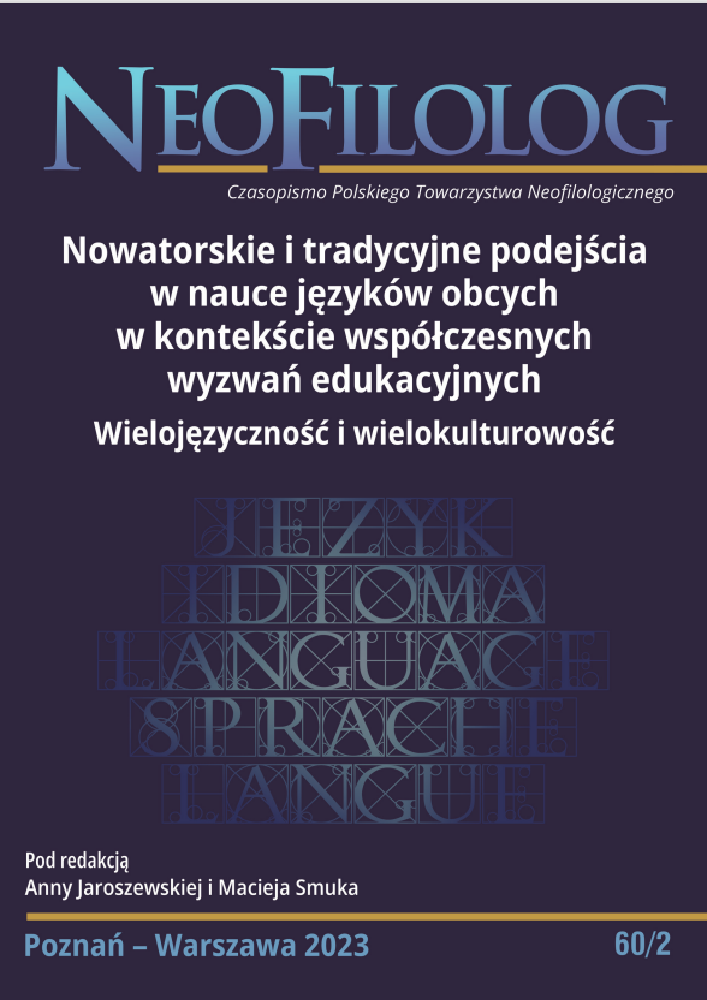Abstract
The purpose of this article is to present the results of empirical research conducted with students taking a foreign language certification test. The aim of the study was to diagnose the extent to which the students interviewed are able to mediate texts. In other words, we wanted to examine whether they possess the knowledge and skills necessary to reconstruct the meanings of a text in order to convey the information imposed by the examination task. The article begins with a short presentation of the notion of mediation. It then discusses the place it has been given in the language classroom by the designers of the CEFR. Finally, we present our empirical study: we define its theoretical framework, present the survey questionnaire we used and then proceed to the analysis of the data collected and the discussion of the results.
References
Barmiński J., Niebrzegowska-Bartmińska S. (2009), Tekstologia. Warszawa: Wydawnictwo Naukowe PWN.
Cadre européen commun de référence pour les langues : apprendre, enseigner, évaluer. Volume complémentaire avec de nouveaux descripteurs (2018), Strasbourg : Conseil de l’Europe.
Cadre européen commun de référence pour les langues : apprendre, enseigner, évaluer. Volume complémentaire avec de nouveaux descripteurs (2021), Strasbourg : Conseil de l’Europe.
Cadre européen de référence pour les langues : apprendre, enseigner, évaluer. (2001). Paris : Didier.
Cardinet A. (1995). Pratiquer la médiation en pédagogie. Paris : DUNOD.
Caron G., Fillion L., Scy C., Vasseur Y. (2018), Osez les pédagogies coopératives au collège et au lycée. Paris : ESF sciences humaines.
Coste D., Cavalli, M. (2015), Éducation, mobilité, altérité. Les fonctions de médiation de l’école. Strasbourg : Unités des politiques linguistiques.
Goullier, F (2019), Les clés du Cadre. Enjeux et actualité pour l’enseignement des langues aujourd’hui. Paris : Didier.
Guillaume-Hofnung M. (2020). La médiation. Paris : Presses universitaires de France. DOI: https://doi.org/10.3917/puf.guill.2020.01
Janowska I., Plak M. (2021), Działania mediacyjne w uczeniu się i nauczaniu języków obcych. Od teorii do praktyki. Kraków: Księgarnia Akademicka. DOI: https://doi.org/10.12797/9788381386807
Kucharczyk R., Szymankiewicz K. (2022), (Re)construire le sens à travers les activités de médiation – point de vue des enseignants sur la médiation en classe de langue étrangère en Pologne. « Romanica Wratislaviensia » DOI: https://doi.org/10.19195/0557-2665.69.4
Liquète V. Présentation générale : Formes et enjeux de la médiation In : Médiations [en ligne]. Paris : CNRS Éditions, 2010 (généré le 12 juin 2022). Disponible sur Internet : <http://books.openedition.org/editionscnrs/14724>. ISBN : 9782271121875. [consulté le 09/09/2022].
Robert J.-P., Rosen É. (2010), Dictionnaire pratique du CECR. Paris : Éditions OPHRYS.
Sujecka-Zając J. (2020), De l’enseignant transmetteur à l’enseignant médiateur en classe de langue. Le rôle de la médiation cognitive auprès des élèves en difficulté d’apprentissage, (in :) De Gioia M., Marcon M. (éd.), L’essentiel de la médiation. Le regard des sciences humaines et sociales, Bruxelles-Bern-New York-Oxford-Wien : PIE Peter Lang, pp. 289–305.
License
Copyright (c) 2023 Radosław Kucharczyk

This work is licensed under a Creative Commons Attribution-NoDerivatives 4.0 International License.
Authors
Authors of texts accepted for publication in Neofilolog are required to complete, sign and return to the Editorial team’s office the Agreement for granting a royalty-free license to works with a commitment to grant a CC sub-license.
Under the agreement, the authors of the texts published in Neofilolog grant Adam Mickiewicz University in Poznań a non-exclusive, royalty-free license and authorize the use of Attribution-NoDerivatives 4.0 International (CC BY-ND 4.0) Creative Commons sub-license.
The authors retain the right to the free disposal of the work.
Users
Interested Internet users are entitled to use works that have been published in Neofilolog since 2017, under the following conditions:
▪ attribution – obligation to provide, together with the distributed work, information about the authorship, title, source (link to the original work, DOI) and the license itself.
▪ no derivatives – the work must be preserved in its original form. Without the author's consent, it is not possible to distribute the modified work in the form of translations, publications, etc.
Copyrights are reserved for all texts published since 2017.
Miscellaneous
Adam Mickiewicz University in Poznań retains the property right as a whole (layout, graphic form, title, cover design, logo etc.).

